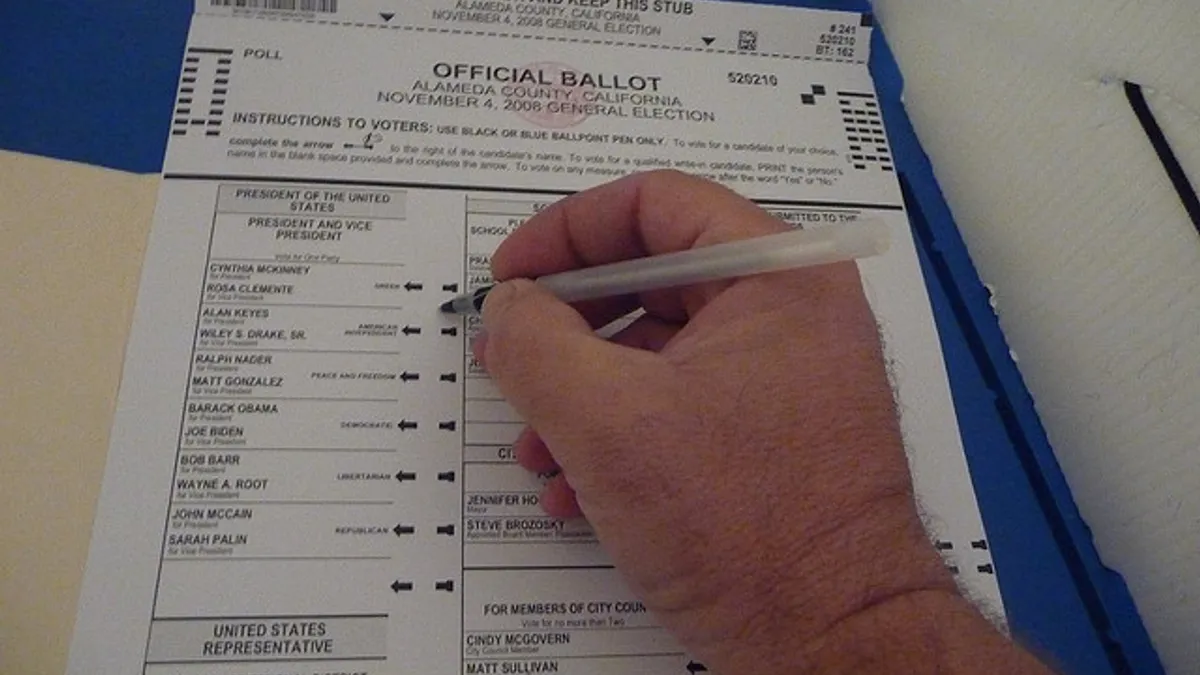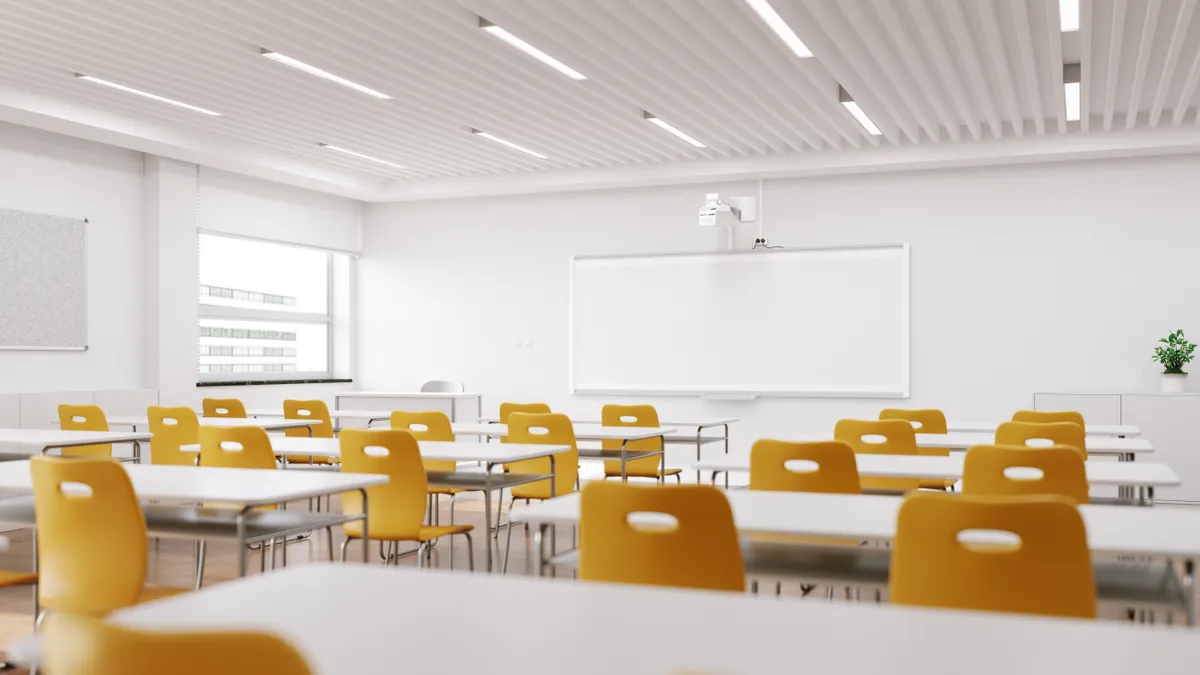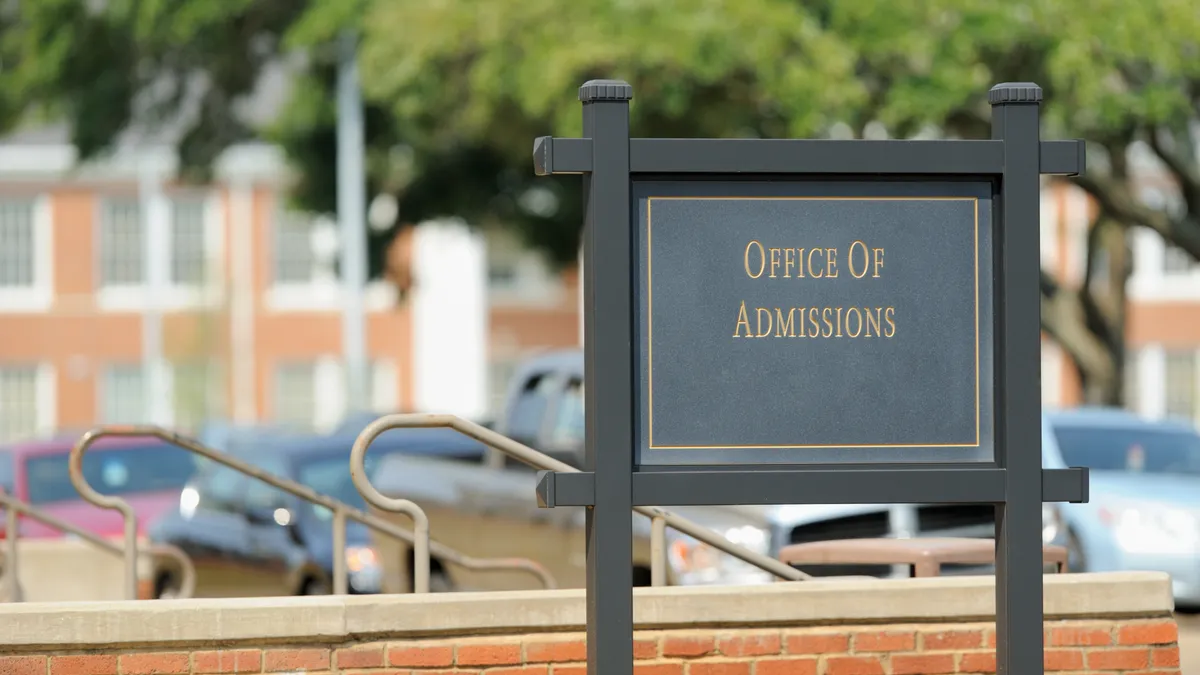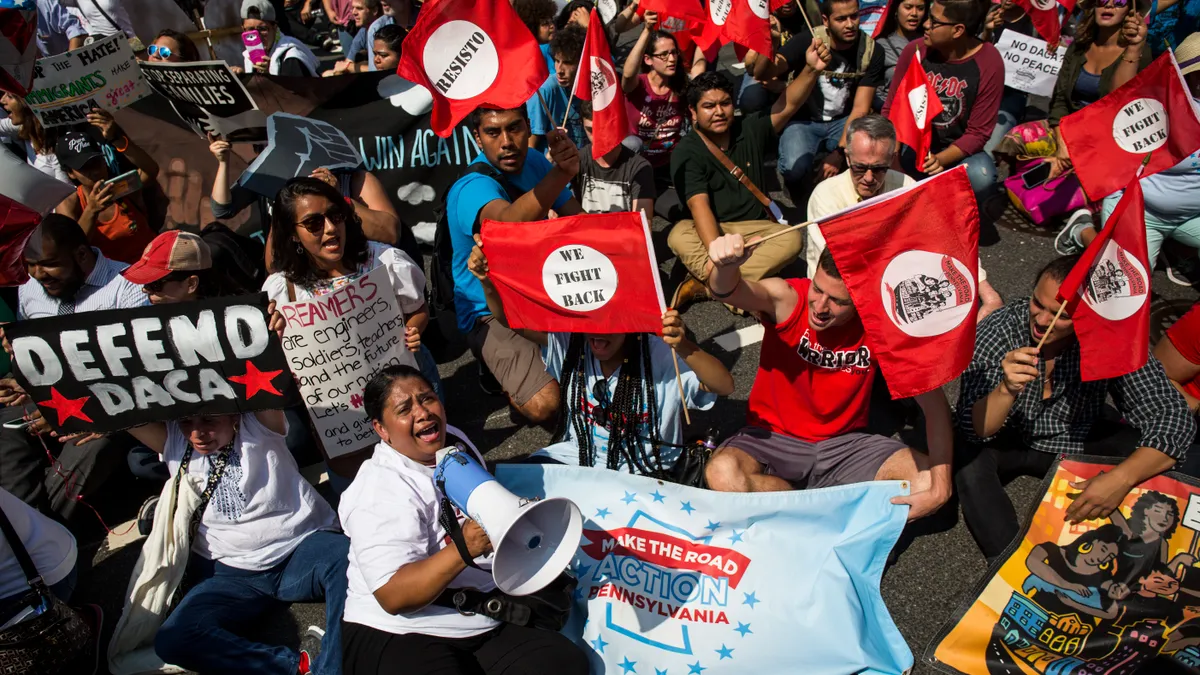On Election Day, voters in California, Georgia, Idaho, Maryland, New Jersey and Washington will determine the future of education in their states. From expected clashes between teacher's unions and politicians to controversial tax increases and in-state tuition for undocumented students, every issue has at least two sides, and over the next few weeks, voters will be asked to make some hard decisions.
At Education Dive, we've looked at what's going to be on the table in six states. From policy and politics to the what's in the proposals and what's at stake, here's a quick rundown of what could happen:
1. CALIFORNIA
What's at stake: The Golden State's budget has an estimated $28 billion deficit. K-12 per-student funding is 47th nationally and is $1000 less than it was five years ago. On Nov. 6, voters will decide between two proposals, Propositions 30 and 38, both of which aim to fix problems in the public school system without worsening the deficit. Since Prop 30 and 38 have conflicting resolutions, if both proposals receive over 50% of the vote, the proposal with the most votes will be enacted.
What's on the ballot: Prop 30, sponsored by Gov. Jerry Brown, would simultaneously increase funds for California's public schools and relieve the budget deficit. The measure increases tax rates between 1-to-3% on a sliding scale over the next seven years for high-income individuals while increasing the state's sales tax by a quarter of a cent over the next four years. The measure promotes realignment, directing funds to local governments rather than having state legislators dictate how they are used. Supporters argue the measure is necessary to prevent nearly $6 billion in automatic trigger cuts whereas opponents believe the resolution will raise taxes on all Californians, stifle small business growth and fail to properly provide funding.
Prop 38 would raise income taxes for 12 years on nearly all Californians on a more gradual sliding scale, from 0.4-to-2.2%, raising $10 billion annually. During its implementation, Prop 38 cannot be amended and funds cannot be diverted. In addition, the legislature cannot replace current funds for schools with Prop 38's revenue. However, if Prop 38 passes, automatic trigger cuts of $6 billion will take place. Supporters argue Prop 38 guarantees the funding needed to radically improve public schools while opponents argue there will be a massive tax increase for low-to-middle-income individuals and small businesses.
2. GEORGIA
What's at stake: In 2008, the Georgia Charter School Commission was created after local school boards repeatedly rejected charter school petitions because they did not want competition. In 2011, the Georgia Supreme Court ruled the Commission was unconstitutional. In May 2012, the state's legislature approved a constitutional amendment to give the state the power to supervise and finance charter schools. On Election Day, individuals in Georgia will vote on a ballot measure to approve or reject the amendment.
What's on the ballot: Amendment 1, approved by the Governor and the Georgia Senate and House of Representatives, needs a majority vote to grant funds to charter schools. Currently, charters apply to the district school board and, if approved, apply to state Board of Education. If denied, the Board of Education can reverse the decision. However, before the Georgia Supreme Court ruling, the Georgia Charter School Commission had power to directly approve public state charter schools. Supporters argue the amendment clarifies and protects the state's ability to approve charter schools, favored by parents who do not want their children to go to the state's failing public schools while opponents argue the measure weakens local school districts and decreases the funding they receive.
3. IDAHO
What's at stake: In 2011, the Idaho legislature and Gov. Otter passed legislation, known as the Luna Laws after public schools superintendent Tom Luna, increasing funding for blended learning while ending tenure for teachers and taking away the majority of their collective bargaining rights. The battle between the teachers and the Governor heated up as both sides accused each other of playing politics at the expense of the children. In June, the teachers gathered enough signatures to put three measures on the Election Day ballot, each one a veto referendum targeting the Luna Laws.
What's on the ballot: Proposition 1, part one of the Idaho Teacher's Collective Bargaining Veto Referendums, intends to reject the Luna Laws that allow schools to renegotiate the length of teacher's contracts and reduce pay without due process, fire employees without formal review, end early retirement incentives, end education support programs with decreased enrollment above 1% and limit negotiations between school boards and staff to compensation with a maximum agreement length of one year.
Proposition 2, part two of the Collective Bargaining Veto Referendums, wants to do away with performance pay based on test scores, graduation rates, dropout rates, percentage of graduates in higher education or the military, percentage of students enrolled in advanced placement classes and many other tracking factors. In addition, Prop 2 will eliminate incentivized and/or higher pay for teachers who take on extra responsibilities and work in harder-to-fill positions. Supporters of the Collective Bargaining Veto Referendums argue that the Luna Laws are austerity measures that unfairly strip teachers of their rights while opponents argue that the teacher's unions are standing in the way of improving the education system.
Proposition 3, the Online Learning Veto Referendum, plans to eliminate laws requiring students to complete at two course credits online, mandatory use of computers in the classroom and the redistribution of funding from teachers' and administrators' pensions, social security and salaries towards the implementation of the technology initiatives. Supporters of the veto referendum argue that teachers are being replaced by technology while opponents assert that technology is needed to improve the public schools system and provide quality education for all.
4. MARYLAND
What's at stake: After the Dream Act was narrowly defeated in the U.S. Senate in 2011, states across the country considered implementing the in-state tuition portion on their own, California being the first state to do so. The California Supreme Court's decision to uphold the law led to Dream Act legislation being introduced in states across the country. Last year in Maryland, Governor O'Malley signed the Dream Act into law despite vocal opposition. On Election Day, voters in Maryland will decide whether or not to keep the law.
What's on the ballot: Question 4 on Maryland's Election Day ballot, known as the Dream Act referendum, asks voters to approve or reject the recently passed law. The Dream Act allows qualified undocumented immigrants to pay in-state tuition rates to attend university. Requirements include having graduated from Maryland's school system, having lived in-state for at least three years and the student's family having paid its income taxes. In addition, the law extends the amount of time honorably discharged military veterans qualify for in-state rates from one year to four years. Supporters contend the law gives undocumented students the same opportunities for higher education as every other student in Maryland while opponents argue that only US citizens are entitled to the education they paid taxes for.
5. NEW JERSEY
What's at stake: According to a recent poll, 87% of voters know little or nothing about the proposed Building Our Future Bond Act that is on the ballot in New Jersey. Although advocates and university administrators lobbied for a much larger $3.5 billion bond issuance, Governor Christie and the state legislature approved a $750 million ballot measure, New Jersey's first Bond Act since 1988. This November, voters will decide whether to authorize the state to sell bonds for higher education funding.
What's on the ballot: If approved, the Building Our Future Bond Act will provide an additional $750 million in funding to the state's institutions of higher education. $300 million will go to public research university, $247.5 million will go towards the remaining four-year public colleges and universities, $150 million will go to county colleges and $52.5 million will go to private institutions with endowments under $1 billion. Participating institutions must fund 25% of their own projects to receive money from the Bond Act. Supporters say the investment in higher education is needed to both maintain and improve education standards in the state while opponents believe that the Bond Act is a fiscally irresponsible piece of legislation, particularly in tough economic times.
6. WASHINGTON
What's at stake: With two education initiatives on Washington's Election Day ballot, voters on Election Day will decide on measures concerning charter schools and public fund investments by public universities in the state. Washington rejected charter school initiatives in 1996, 2000 and 2004, although advocates are remain hopeful. The Public University Investments Amendment faces far less scrutiny, having been passed by the state legislature in a nearly unanimous fashion. The measures come as separate responses to the assertion that the state's public education institutions are failing to meet the needs of all of their students.
What's on the ballot: SJR 8223, more commonly known as the Washington Public University Investments Amendment, would allow the University of Washington and Washington State University to legally invest public funds. Supporters argue funds for the University of Washington and Washington State University will increase without an increase in taxes while opponents believe it is irresponsible to risk public funds.
Initiative 1240, the Washington Charter School Initiative, would establish a nine-person state charter school commission which would have exclusive power, unless school districts apply for it themselves, to approve charters. Charter schools do not need to follow the same rules as public schools in exchange for significant improvements in the standard of education. Two types of charters would be allowed: newly formed charters and conversion charters, meaning public schools in which the teachers or parents vote to turn the school into a charter. Supporters argue charter schools improve the quality of education, especially with regard to the serious achievement gap in Washington, while providing a variety of options to parents and students. Opponents claim the schools will deplete public schools funding while only helping a small minority of students without any guarantee of improvement.
Want to see more education news and resources like this in your inbox on a daily basis? Subscribe to the Education Dive email newsletter! You may also want to read our "5 education issues in the 2012 U.S. presidential election" list and follow Education Dive on Twitter.








 Dive Awards
Dive Awards














